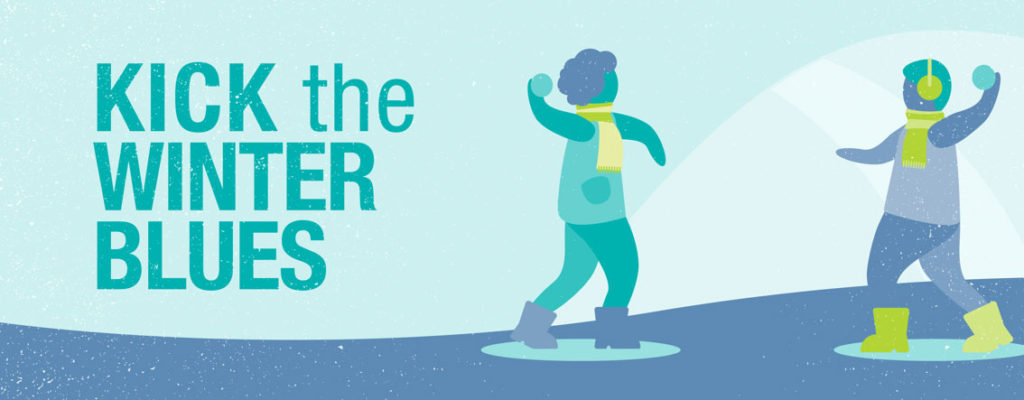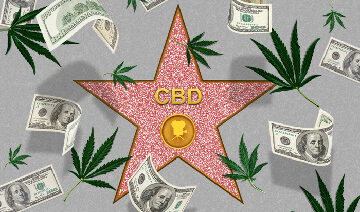
It’s almost that time of year again…the Winter Blues. For many Americans, winter is the worst season…and who could blame them? Even during the holiday festivities, Northerners have to contend with dark, short days and bone-chilling temps. Add in a few potholes, snowstorms, and bills as high as a Christmas tree, and you could understand why seasonal affective disorder (SAD) is such a big issue.
Can CBD ward off seasonal affective disorder? While it hasn’t yet been extensively tested on SAD patients, there’s some evidence CBD could help people keep their calm during this often dreary time of year. Keep reading to see how CBD might keep you smiling through the snowy season.
What Is Seasonal Affective Disorder?
The Diagnostic Manual of Mental Disorders (DSM-5) defines SAD as a type of depression – Major Depressive Disorder with Seasonal Pattern. SAD can happen in the summer, but it’s more prevalent in the fall as the seasons change and the days get shorter, according to the American Psychiatric Association.
SAD is more than just ‘winter blues.’ The symptoms can be distressing and overwhelming and can interfere with daily functioning. The theory behind seasonal affective disorder is straightforward: weather affects our mood. If it’s gloomy outside, most people will probably feel gloomy inside. While everyone experiences these changes to some extent, SAD patients tend to be more sensitive to seasonal variations.
Scientifically speaking, SAD is a variant of major depression, and patients tend to experience similar depressive symptoms. Common warning signs of SAD include fatigue, changes in appetite, difficulty concentrating, and social withdrawal. The only difference between major depression and SAD is that seasonal variations trigger the latter.
While researchers believe SAD has a genetic component, they still aren’t sure what causes this disorder. However, some researchers suggest the sleep hormone melatonin may play a role. Others hypothesize that neurotransmitters like dopamine and serotonin could influence a person’s susceptibility to SAD.
Seasonal Affective Disorder Diagnosis
A SAD diagnosis requires a person to have major depression for at least two years and that the depression coincides with winter or summer seasons. According to the National Institute of Mental Health, signs of major depression include:
- Feeling depressed most of the day, nearly every day
- Feeling hopeless or worthless
- Having low energy
- Losing interest in activities you once enjoyed
- Having problems with sleep
- Experiencing changes in your appetite or weight
- Feeling sluggish or agitated
- Having difficulty concentrating
- Having frequent thoughts of death or suicide
Additionally, symptoms of winter SAD include:
- Having low energy
- Excessive daytime sleepiness
- Overeating
- Weight gain
- Craving for carbohydrates
- Social withdrawal (feel like “hibernating”)
An estimated 10 million Americans suffer from SAD, and several factors make one more susceptible. Women are four times more likely to suffer from SAD than men. It often starts between ages 18 and 30 and is more likely to occur in people who live far north (such as New England) or south of the equator. SAD tends to be at its worst in the Northern Hemisphere in January and February. Family history and a history of depression or bipolar disorder can also raise the risk.
Could CBD Bust Your “Winter Blues?” – The Benefits of CBD for Depression

Here’s where CBD comes in. The most common medication prescribed for SAD is antidepressants alone or combined with counseling, Vitamin D, or light therapy. As we noted, there is no clinical data examining CBD’s effects on SAD. However, there’s a growing body of evidence that suggests CBD could ease anxiety and depression symptoms.
CBD may be an alternative because it is effective in relieving some of the symptoms of SAD. For instance, insomnia and anxiety can be symptoms of seasonal affective disorder. A 2010 study found that CBD decreased social anxiety, and a 2014 study determined that CBD had antidepressant and antianxiety properties. One study out of Kyoto University examined the effects of CBD on a group of teens with social anxiety. Interestingly, the students who took CBD said they felt less stressed versus the placebo group. The University of São Paulo confirmed these findings in a similar placebo-controlled study.
In a 2015 study, researchers concluded that CBD has “considerable potential as a treatment for multiple anxiety disorders.” A 2016 study published in the journal Neuropharmacology reported that “findings indicate that CBD could represent a novel fast antidepressant drug.”
What is CBD?
If you’re reading this and wondering, “Well that all sounds great, but what exactly is this CBD stuff?” then this section may prove educational.
CBD is an acronym for cannabidiol, a compound that occurs naturally in both marijuana and hemp. Most CBD comes from the agricultural hemp plant, a fast-growing member of flowering plants in the family Cannabaceae. Marijuana belongs to the same family of plants. While marijuana and hemp are similar in many ways, they differ in their phytochemical composition. Hemp has lower concentrations of tetrahydrocannabinol, or THC, the psychoactive compound in marijuana that gets you “high,” and it has higher concentrations of CBD, which doesn’t produce the “high” of marijuana.
Antidepressant therapy can be a trial-and-error process. Many undesirable side effects, such as shakiness, nausea, weight gain, and sex drive loss, are associated with antidepressants.
CBD, on the other hand, has almost no side effects. Some side effects are minor and may include drowsiness and dry mouth. And CBD is safe: Clinical trials have prescribed CBD doses up to 1,200 mg daily for months without observing any serious side effects. And a US Government patent concludes that “No signs of toxicity or serious side effects have been observed following chronic administration of cannabidiol to healthy volunteers … even in large acute doses of 700 mg/day.”
How Much CBD Should I Take?
There are several factors in deciding on how much CBD to take. First, quality, purity, and concentration are factors. Any CBD product you use should be made from 100% pure CBD, and the label should also show how much CBD there is per mg. Reputable brands, have their CBD tested by a third-party independent lab, and the results posted on the company website. That way, you can be sure you’re getting the amount of CBD on the label and that the product is free from THC, contaminants, and other harmful substances.
Other factors include weight, metabolism, method of consumption, and how and when you take it.
And finally, the dosage matters. It’s important to know that CBD is currently unregulated, and there are no guidelines for a standard dose of CBD; everyone’s experience is different. It’s advisable to “start low and go slow,” although many people don’t take enough CBD to see the results they seek. You can download a copy of our dosage guide to get some sense of the starting dosages we would recommend, and you should also feel free to reach out to us directly if you have any questions or would like assistance in determining a proper starting dosage.
Final Thoughts
While CBD can help SAD patients, we always suggest using CBD to complement a healthy lifestyle. In the case of SAD, we strongly recommend taking CBD in conjunction with other standard therapies such as bright light exposure, regular exercise, and a diet high in omega-3s. It’s also crucial for SAD patients to get their vitamin D levels checked by a qualified doctor.
Putting all of these strategies together should help keep you smiling even on the darkest of days!

PLEASE NOTE
The contents of this blog are provided for informational purposes only and are not intended as a substitute for the consultation, diagnosis and/or medical advice and treatment of a qualified physician or healthcare professional. As with any product, please consult your care provider if you have any concerns prior to use.


